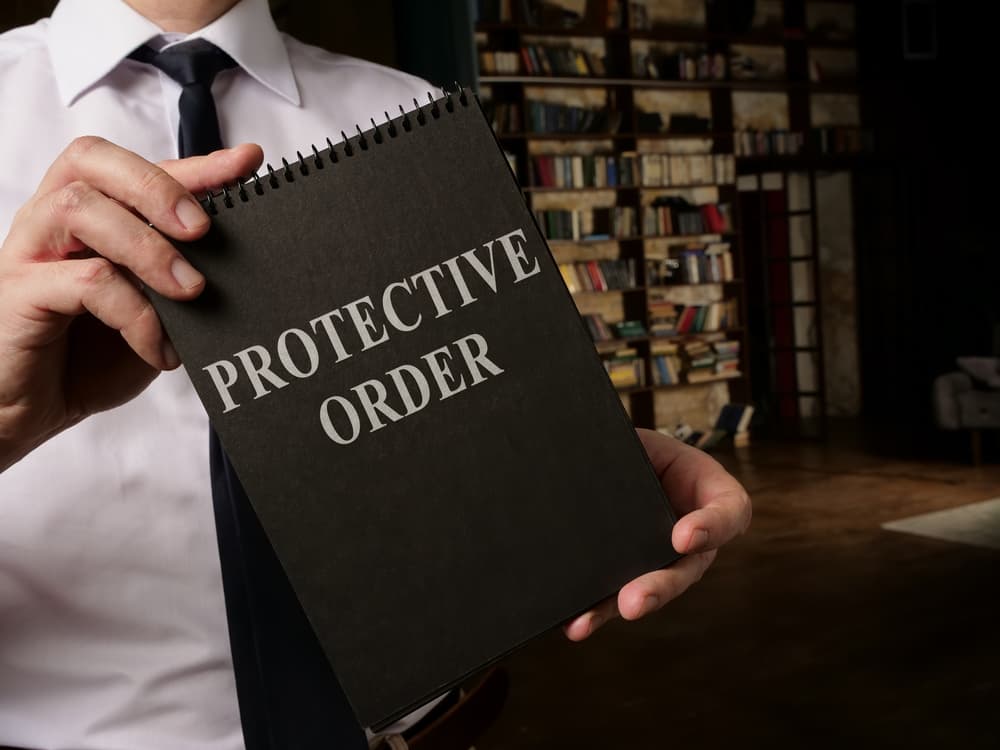Understanding the implications of a restraining order is important, whether you’re seeking protection or you’ve been informed that one may be filed against you.
This guide aims to shed light on the consequences of restraining orders, aiming to provide clarity and peace of mind during what can be a challenging time.
We’ll explore what restraining orders are, the types available, their impacts on those involved, and how a criminal defense lawyer can support you through the process.
What Is a Restraining Order?

A restraining order, widely recognized as a protective order, is a legal measure enforced by a court to protect people from different forms of harm or harassment. This judicial decree serves as a barrier against potential threats, aiming to stop any ongoing or future abusive, threatening, or harassing behavior.
The essence of a restraining order lies in its ability to restrict the actions of the person it targets, thereby providing a layer of protection to those who feel endangered.
At its core, a restraining order is a directive from the court that sets specific legal boundaries for the person against whom it is issued. These boundaries can include prohibitions on physical proximity, direct or indirect communication, and other forms of contact with the person seeking protection. The intent is to create a safe and controlled environment for the petitioner, reducing the risk of further harm or distress.
The process of obtaining a restraining order typically begins with the filing of a petition in court. This document outlines the petitioner’s reasons for requesting the order, detailing instances of abuse, threats, or harassment. It is important for the petitioner to provide evidence supporting their claims to persuade the court of the necessity of such a protective measure.
Depending on the urgency of the situation, the court may issue a temporary restraining order (TRO) to provide immediate protection while awaiting a more comprehensive hearing. This hearing determines whether a longer-term or permanent restraining order is warranted based on the evidence presented.
Restraining orders are not one-size-fits-all; they are tailored to address the specific needs and circumstances of the individual seeking protection. For instance, in cases of domestic violence, a restraining order can include stipulations regarding child custody, visitation rights, and financial support, in addition to prohibitions on contact and proximity.
In other scenarios, such as stalking or workplace harassment, the order may focus more on keeping the perpetrator away from the victim’s home, workplace, or other significant locations.
The impact of a restraining order extends beyond the immediate legal restrictions it imposes on the respondent. It also serves as a formal acknowledgment of the victim’s experiences, offering a sense of validation and security. Also, it provides a legal framework for addressing any violations of the order.
Violating a restraining order is a criminal offense that can lead to arrest and prosecution, emphasizing the seriousness of adhering to the court’s directives.
Types of Restraining Orders
There are several types of restraining orders, each tailored to specific situations:
Domestic Violence Restraining Orders
Domestic Violence Restraining Orders provide safety and security for people who find themselves in threatening situations with someone they share a close personal relationship with. This order specifically addresses issues of abuse within intimate relationships, families, or households.
A Domestic Violence Restraining Order attempts to prevent physical harm as well as psychological, emotional, and financial abuse.
When granted, these orders can impose various restrictions on the abuser, such as prohibiting contact with the victim, ordering them to stay away from the victim’s home, workplace, or children’s schools, and sometimes even requiring them to move out of a shared residence.
In addition to these protective measures, the court may also make provisions for child custody, visitation rights, and financial support to ensure the safety and welfare of the victim and any children involved.
The process for obtaining a Domestic Violence Restraining Order typically involves the victim filing a petition with the court, detailing the nature of the abuse and the kind of protection they are seeking.
Urgent cases may qualify for a temporary order, which is issued swiftly to provide immediate protection until a full court hearing can be held to decide on a more permanent solution.
Civil Harassment Restraining Orders
Civil Harassment Restraining Orders serve to protect individuals from non-domestic abuse, such as stalking, harassment, or threats from neighbors, acquaintances, or even strangers.
This type of order is crucial for situations where the perpetrator does not have an intimate or familial relationship with the victim, thus falling outside the purview of domestic violence protections.
The scope of a Civil Harassment Restraining Order can include prohibitions against following or stalking the victim, direct or indirect attempts to contact or harass, and threats of violence.
It aims to create a safe distance between the harasser and the victim, often specifying that the perpetrator must stay a certain distance away from the victim’s home, workplace, and other places frequented by the victim.
Obtaining this type of restraining order involves presenting evidence of harassment or threats to a court, demonstrating the need for legal protection. The legal threshold for what constitutes harassment can vary, but generally, the victim must prove that they have suffered substantial emotional distress due to the actions of the perpetrator.
Workplace Violence Restraining Orders
Workplace Violence Restraining Orders are a specialized form of legal protection designed to protect employees from threats or acts of violence in their place of employment. This type of order is unique in that it is requested by the employer on behalf of the employee(s) facing danger.
It recognizes the employer’s responsibility to provide a safe working environment and offers a legal remedy to address situations where an individual’s safety at work is compromised by the violent or threatening actions of another.
These orders can restrict the perpetrator from entering the workplace, making contact with the employees, or engaging in further threatening behavior. In some cases, they may also extend protection to the employee’s family members if there is a demonstrable threat to their safety as well.
Workplace Violence Restraining Orders are particularly relevant in situations where the perpetrator may not have a personal relationship with the employee, such as disgruntled former employees, clients, or customers.
The process for securing a Workplace Violence Restraining Order typically requires the employer to file a petition with the court, presenting evidence of the threat or violence that has occurred or is likely to occur. The court then assesses the situation and determines whether to grant the restraining order to ensure the safety of the employees and maintain a secure working environment.
In all these cases, the primary objective of restraining orders is to prevent further harm or harassment, ensuring the safety and well-being of those at risk.
Consequences for the Restrained Person
The implications of being subject to a restraining order can damage your life in these ways:
Legal Restrictions
- Proximity Limitations: As the restrained person, you may be prohibited from coming within a certain distance of the petitioner’s home, workplace, or other specified locations.
- Communication Bans: Direct or indirect contact with the protected person may be forbidden. This includes phone calls, messages, emails, and social media interaction.
- Firearm Restrictions: In many jurisdictions, people under a restraining order are not allowed to own or possess firearms.
- Temporary Custody Orders: A restraining order might temporarily modify custody arrangements to protect the children involved.
Personal and Professional Impacts
- Employment: A restraining order can affect current employment and future job prospects, especially for positions requiring background checks.
- Housing: Some landlords may refuse to rent to people with restraining orders against them.
- Reputation: The social stigma attached to a restraining order can harm your personal relationships and community standing.
Legal Consequences
- Record of Order: A restraining order becomes part of the public record, which can have lasting effects on your personal and professional life.
- Potential Criminal Charges: Violating a restraining order is a criminal offense that can lead to arrest, fines, and even imprisonment.
Consequences for the Protected Person
For the individual seeking a restraining order, the consequences are primarily protective in nature, aimed at ensuring safety and peace of mind:
- Safety Measures: The order provides a legal mechanism to protect against threats, harassment, or violence.
- Legal Recourse: Violations of the order by the restrained person can lead to their arrest and prosecution, offering further protection.
- Peace of Mind: Knowing that there are legal repercussions for any violations can offer a sense of security.
How a Lawyer Can Assist With Restraining Orders

Dealing with restraining orders can be a difficult process, filled with legal intricacies and emotional stress. However, hiring a knowledgeable lawyer can significantly ease this burden, offering essential support, guidance, and representation.
Below is an expanded look at how a lawyer can assist you throughout the restraining order process:
Understanding and Filing for a Restraining Order
A lawyer can help you navigate the initial stages of obtaining a restraining order.
They can:
- Clarify the Different Types: Lawyers can explain the various restraining orders—such as domestic violence, civil harassment, and workplace violence orders—ensuring you understand each type’s specific criteria and protections.
- Assess Your Situation: By evaluating the details of your case, a lawyer can recommend the most appropriate type of restraining order to pursue based on your circumstances and the nature of the threat or harassment you’re facing.
- Prepare and File the Necessary Documents: Completing and filing the legal paperwork for a restraining order can be complicated. A lawyer will ensure that all documents are accurately prepared, filed on time, and meet all legal requirements, thereby avoiding delays or rejections.
Representation in Court
Having legal representation during court proceedings is valuable.
A lawyer will:
- Advocate on Your Behalf: Your lawyer will present your case in the most compelling way, arguing why the restraining order is necessary for your protection.
- Handle Legal Procedures and Arguments: A lawyer will be well-versed in court procedures and can effectively manage the legal aspects of your case, including responding to any challenges from the opposing side.
- Provide Emotional Support: Knowing you have a professional advocate can offer significant emotional relief during what is often a stressful court experience.
Advice and Support
Beyond the filing and court representation, a lawyer’s advice and ongoing support are indispensable throughout the restraining order process.
A lawyer can:
- Explain Your Rights and the Implications: A lawyer will help you understand your rights under the law and the implications of the restraining order, both for you and the restrained person.
- Strategize for Safety and Compliance: They can advise on strategies to ensure your safety and the legal compliance of the restraining order, including what to do if you violate the order.
- Navigate Post-Order Issues: After a restraining order is granted, you may need further legal assistance, whether to enforce the order, address violations, or manage related legal matters like custody or divorce. A lawyer can guide you through these challenges.
Contact a Lawyer for Next Steps
If you find yourself needing to respond to a restraining order, you need legal representation. The journey ahead may seem difficult, but you don’t have to go down it alone. A lawyer can provide the clarity, support, and representation you need to move forward with confidence.

With a dedicated legal advocate by your side, you can ensure that your rights are protected, your case is presented compellingly, and any legal issues are handled. From understanding the nuances of different restraining orders to representing you in court and advising on post-order strategies, a lawyer will be your ally every step of the way.
Don’t let uncertainty or fear dictate your next steps. Reach out to a lawyer today to discuss your situation and explore your options. When you’re facing a protection order, professional legal assistance can make all the difference.
Take the first step towards securing your safety and legal rights. Contact a lawyer to get the support and guidance you deserve.


